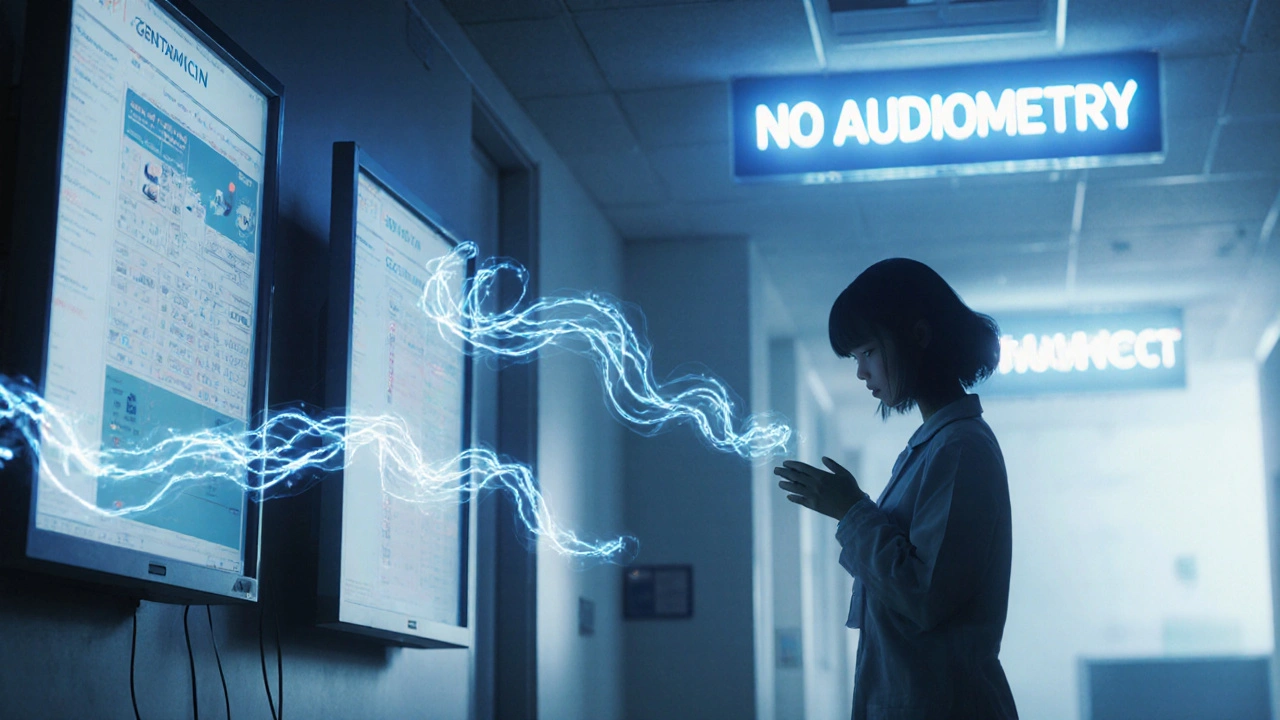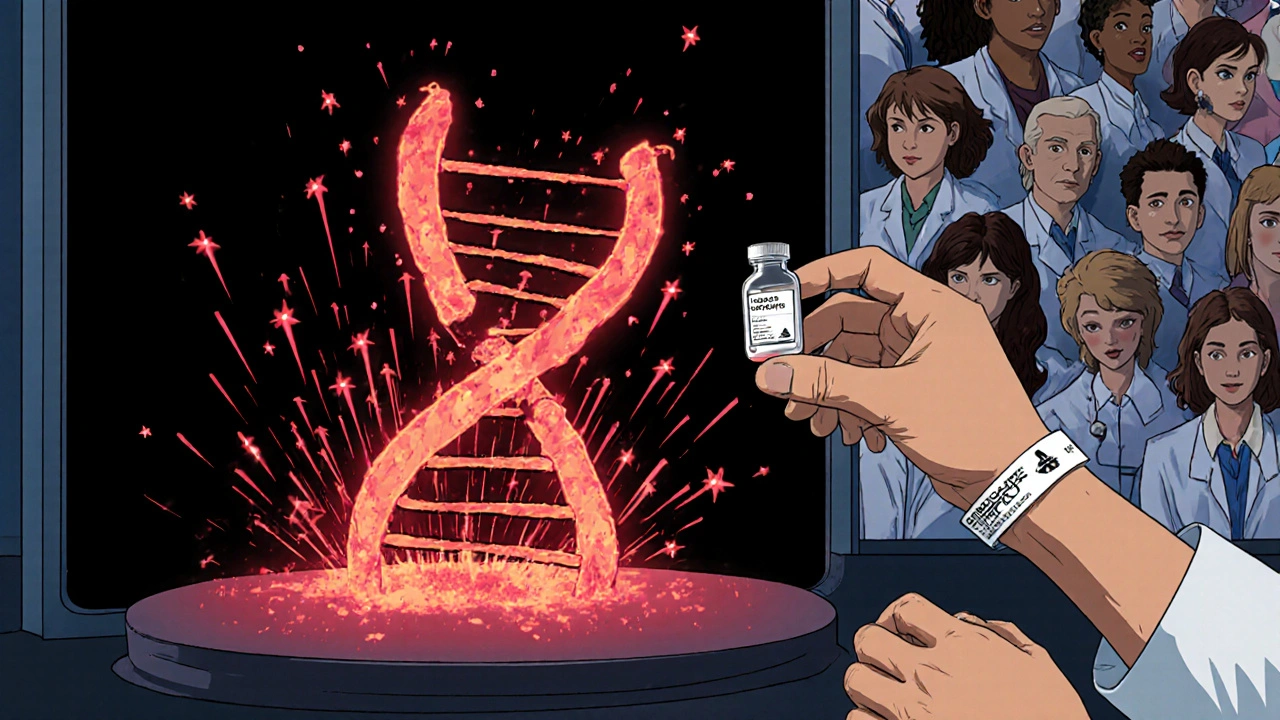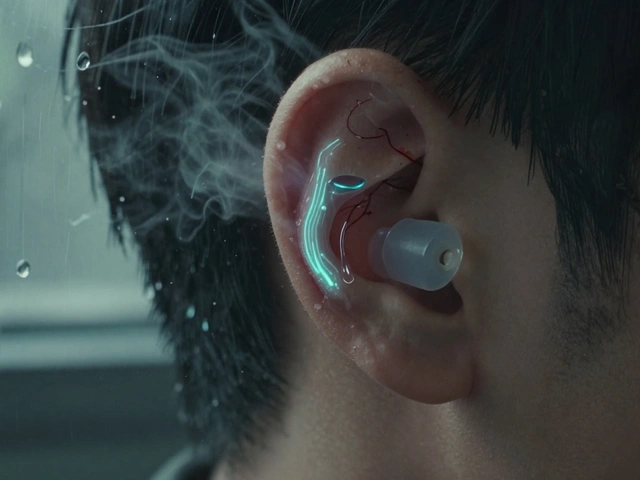Aminoglycoside Ototoxicity Risk Calculator
How This Calculator Works
This tool estimates your risk of permanent hearing and balance damage from aminoglycoside antibiotics based on key factors discussed in the article. Your results will show your calculated risk level and personalized recommendations.
When you’re fighting a life-threatening infection, antibiotics are a lifeline. But some of the most powerful ones - aminoglycosides like gentamicin, amikacin, and tobramycin - come with a hidden cost: aminoglycoside ototoxicity. This isn’t a rare side effect. It’s a silent, often permanent injury to your ears that can leave you with hearing loss, ringing in your ears, and trouble staying balanced - even after the infection is gone.
How Aminoglycosides Attack Your Inner Ear
Aminoglycosides don’t just kill bacteria. Once they enter your bloodstream, they find their way into the inner ear. They cross the blood-labyrinth barrier, usually through the stria vascularis, and get absorbed by the delicate hair cells in your cochlea and vestibular system. These hair cells are your body’s sound and balance sensors. Once damaged, they don’t regenerate. The damage starts in the high-frequency regions of the cochlea - the part that lets you hear birds chirping, children’s voices, or the hiss of a teakettle. That’s why many people don’t notice right away. Standard hearing tests, which check frequencies from 250 Hz to 8 kHz, often miss the early signs. But high-frequency audiometry (9-16 kHz) can catch it 5 to 7 days earlier. By the time you fail a routine test, the damage is often irreversible. These drugs trigger a chain reaction inside hair cells. They overactivate NMDA receptors, which flood cells with nitric oxide. That leads to oxidative stress, free radical buildup, and eventually, cell death. Unlike cisplatin - another ototoxic drug - aminoglycosides cause both apoptosis (programmed cell death) and necrosis (cell rupture). The result? Permanent loss of hair cells. No comeback.It’s Not Just About Hearing - Balance Is at Risk Too
Most people focus on hearing loss, but vestibular damage is just as serious - and often overlooked. About 15% to 30% of patients on long-term aminoglycosides develop vestibular toxicity. That means dizziness, vertigo, unsteadiness, and difficulty walking in the dark or on uneven surfaces. A case from Johns Hopkins in 2022 showed a 34-year-old woman who developed bilateral vestibular loss after just 10 days of gentamicin for urosepsis. She spent 14 months in vestibular rehabilitation just to walk without falling. Her hearing was fine, but her world had become unstable. That’s the reality for many. Unlike hearing loss, vestibular damage doesn’t show up on audiograms. It requires specialized balance tests - electronystagmography or video head impulse testing - which aren’t routinely ordered. So patients are often told they’re “just anxious” or “getting older.”Genetics Play a Bigger Role Than You Think
Why do some people lose their hearing after one dose, while others take weeks? Genetics. A mutation in mitochondrial DNA - specifically the A1555G or C1494T variants in the 12S rRNA gene - makes your hair cells extremely vulnerable. These mutations disrupt how mitochondria make proteins, and when aminoglycosides show up, they lock onto the faulty machinery and shut it down completely. The T1095C mutation makes gentamicin-induced cell death 47% worse. People with these mutations can go from normal hearing to profound deafness after a single course of antibiotics. And here’s the kicker: most don’t know they carry them until it’s too late. The OtoSCOPE® genetic test can screen for these mutations with 94.7% accuracy. It’s available, affordable, and recommended before long-term aminoglycoside use - especially for TB patients or those in intensive care. Yet only 37% of U.S. hospitals have any formal ototoxicity monitoring program. In low-income countries, it’s closer to 18%.
Noise Makes It Worse - A Lot Worse
If you’re around loud noise while taking aminoglycosides, your risk of hearing loss spikes. Studies show exposure to loud sounds - even weeks before or after treatment - can increase ototoxicity by 38% to 52%. It’s not just a coincidence. Noise stresses the inner ear, making the blood-labyrinth barrier leakier and letting more drug in. It also weakens the hair cells’ defenses. A 2021 study found that people who worked in noisy environments or went to concerts before or during treatment had significantly worse outcomes. If you’re on gentamicin, avoid concerts, power tools, or even loud lawnmowers. Even background noise in hospitals - alarms, carts, TVs - can add up.Who’s Most at Risk?
You’re at higher risk if:- You’re being treated for multidrug-resistant tuberculosis (68% of ototoxicity cases occur here)
- You’ve had prior hearing loss, especially in high frequencies (3.2 times more likely to lose lower frequencies)
- You’re elderly or have kidney problems (aminoglycosides are cleared by kidneys - poor clearance means higher drug levels)
- You’re receiving high doses or treatment longer than 7 days (41% of cases develop within that window)
- You’re in a low-resource setting where monitoring isn’t available
Monitoring Can Save Your Hearing - If It’s Done Right
The good news? We know how to prevent most cases. But it requires action.- Baseline hearing test within 24 hours of starting treatment - using high-frequency audiometry.
- Repeat testing every 48-72 hours during treatment. A 10 dB drop at 8 kHz or higher is a red flag.
- Therapeutic drug monitoring - checking peak and trough blood levels. Staying in the therapeutic range cuts ototoxicity risk by 28%.
- Genetic screening for A1555G/C1494T mutations - especially before long-term use.
- Stop the drug immediately if hearing loss is detected. Delaying by even 24 hours can make damage permanent.

What’s Being Done to Fix This?
There’s hope on the horizon. The FDA gave Fast Track status to ORC-13661, a drug that protects hair cells during aminoglycoside treatment. In Phase II trials, it preserved hearing by up to 30 dB across frequencies when given with amikacin. It’s not a cure, but it could be a shield. Researchers at St. Jude are testing compounds that block MET channels - the tiny gates on hair cells that let aminoglycosides in. In mice, these blockers prevented hearing loss without reducing antibiotic effectiveness. Gene therapy is also being explored. The Hearing Restoration Project is developing treatments to correct mitochondrial mutations before they cause damage. Early results show a 67% reduction in ototoxicity in animal models. But these advances won’t help the 80% of aminoglycoside use happening in places with no labs, no genetic tests, and no audiologists.What You Can Do - Even If You’re Not a Doctor
If you or a loved one is prescribed an aminoglycoside:- Ask: “Is this absolutely necessary? Are there alternatives?”
- Ask: “Will you be doing baseline and follow-up hearing tests?”
- Ask: “Has anyone in my family had unexplained hearing loss? I might carry a genetic risk.”
- Ask: “Can you check my drug levels?”
- Stay quiet. Avoid loud environments. Use earplugs if you can’t.
- Report any ringing, muffled hearing, or dizziness immediately - don’t wait.
The Harsh Reality
A 2022 survey of 217 patients found 89% were never warned about ototoxicity before treatment. Seventy-four percent said their hearing loss ruined their quality of life - affecting relationships, work, and mental health. Many felt betrayed. They trusted their doctors. They didn’t know antibiotics could steal their hearing. The American Academy of Audiology calls aminoglycoside ototoxicity the third leading cause of acquired hearing loss in hospitals - after aging and noise. And yet, it’s preventable. We have the tools. We have the science. What’s missing is the will.Can aminoglycoside hearing loss be reversed?
No. Once the hair cells in your inner ear die, they don’t grow back. Aminoglycoside-induced hearing loss and vestibular damage are permanent. The only way to prevent it is early detection and stopping the drug before significant damage occurs.
How soon after starting aminoglycosides can hearing loss begin?
Hearing loss can start as early as 2-3 days after beginning treatment, though it’s often detected around day 5-7. Vestibular symptoms may appear later, sometimes after 7-10 days. This is why daily or every-other-day hearing checks are critical - waiting for symptoms to appear means it’s already too late.
Are there safer antibiotics than aminoglycosides?
Yes - but only in some cases. For many serious infections like sepsis or drug-resistant TB, aminoglycosides are still the most effective option. Alternatives like carbapenems or fluoroquinolones may be used, but they have their own risks, including resistance development. The goal isn’t always to avoid aminoglycosides - it’s to use them safely with proper monitoring.
Can genetic testing prevent aminoglycoside ototoxicity?
Yes, if done before treatment. The OtoSCOPE® test identifies mitochondrial mutations that make people extremely sensitive to aminoglycosides. If you test positive, doctors can choose a different antibiotic or take extra precautions. This test is especially important for people with a family history of unexplained hearing loss or those from populations with higher mutation rates, like East Asians and Europeans.
Why don’t all hospitals monitor for ototoxicity?
Cost, lack of awareness, and outdated protocols. Many hospitals still rely on outdated guidelines that don’t require regular hearing tests. Audiologists aren’t always on staff, and staff don’t know how to interpret results. In low-income countries, the problem is worse - there’s often no equipment or trained personnel. But the cost of untreated hearing loss - rehabilitation, social isolation, lost income - far outweighs the cost of monitoring.
What should I do if I develop tinnitus after taking gentamicin?
Contact your doctor immediately. Tinnitus is often the first sign of ototoxicity. Don’t wait for it to get worse. Request a high-frequency audiogram right away. If hearing loss is confirmed, stopping the drug may prevent further damage. Even if the infection isn’t fully treated, switching to a non-ototoxic alternative is often possible and safer than risking permanent hearing loss.
Is melatonin helpful or harmful for aminoglycoside ototoxicity?
The evidence is mixed. Some studies suggest melatonin’s antioxidant properties might protect hair cells. Others, including a 2005 study, found it worsened damage - possibly because it constricts blood vessels in the inner ear, reducing oxygen flow. Until more research is done, avoid taking melatonin supplements during aminoglycoside treatment unless directed by a specialist.
How common is aminoglycoside ototoxicity in real-world use?
Studies show 20% to 47% of patients develop some degree of hearing loss. In high-risk groups - like TB patients or ICU cases - the rate can be over 60%. And 78% of patients on Reddit reporting ototoxicity said their hearing loss was permanent. These aren’t rare side effects - they’re predictable, preventable tragedies.






Shayne Smith
November 3, 2025 AT 02:45Wow. I had no idea antibiotics could do this. My grandma lost her hearing after a hospital stay-no one ever connected the dots. This post should be mandatory reading for every ER doc.
Kay Jolie
November 3, 2025 AT 16:20Let’s be real-aminoglycoside ototoxicity isn’t a side effect, it’s a bioethical failure. We’re weaponizing mitochondrial vulnerabilities in a system that doesn’t screen for them. The fact that we still use these drugs without OtoSCOPE® pre-screening is medical malpractice dressed up as protocol.
Clare Fox
November 4, 2025 AT 15:55i’ve been tinnitused since my last round of gentamicin. no one told me. i thought it was just stress. turns out i’m one of those 89% who got blindsided. now i’m 32 and can’t hear my dog bark. thanks, medicine.
Billy Schimmel
November 6, 2025 AT 08:20So let me get this straight… we’ve got a drug that can blind you to high frequencies, wreck your balance, and we don’t even test for genetic risk? And people wonder why trust in doctors is gone?
Max Manoles
November 6, 2025 AT 21:15The 2021 study on noise amplification is particularly chilling. The blood-labyrinth barrier isn’t just a filter-it’s a fragile dam. When you add acoustic stress to pharmacological assault, you’re essentially turning the cochlea into a pressure cooker. This isn’t negligence; it’s systemic negligence.
pallavi khushwani
November 8, 2025 AT 04:45It’s funny how we’ll spend millions on AI to diagnose cancer, but won’t spend $50 to test if someone’s DNA will turn their antibiotics into poison. We treat hearing like a luxury, not a human right.
Inna Borovik
November 8, 2025 AT 23:59Everyone’s talking about genetics, but nobody’s asking why we’re still using aminoglycosides at all. We have carbapenems, tigecycline, even newer beta-lactamase inhibitors. If we’re this aware of the damage, why are we still gambling with people’s ears? This isn’t science-it’s inertia.
Ashish Vazirani
November 9, 2025 AT 22:56India has over 12 million TB cases a year… and zero ototoxicity protocols. We’re not just failing patients-we’re weaponizing poverty. Gentamicin is cheap, yes. But deafness? That’s a lifetime cost. Who’s paying for the cochlear implants? The government? The patient? The silence is louder than the tinnitus.
Katie O'Connell
November 11, 2025 AT 05:46It is deeply concerning that the American Academy of Audiology has designated this as the third leading cause of acquired hearing loss, yet no federal mandate exists for monitoring. This is not a gap in medical knowledge-it is a gap in moral accountability.
Gwyneth Agnes
November 11, 2025 AT 13:46Stop the drug. Now. If you hear ringing, don’t wait. It’s already too late.
Akash Takyar
November 12, 2025 AT 22:15For those in high-risk groups: please, please ask for the OtoSCOPE® test. It’s not expensive. It’s not invasive. And it could save your ability to hear your child’s voice. Don’t wait for a tragedy to become a statistic.
Dan Cole
November 13, 2025 AT 00:10The real tragedy isn’t the ototoxicity-it’s that we’ve normalized it. We’ve turned irreversible neural death into a ‘known risk’ on a consent form. That’s not informed consent; that’s institutionalized fatalism. We’ve stopped fighting for patients because it’s ‘too complicated.’
Mansi Bansal
November 14, 2025 AT 16:06As a clinical pharmacologist with over two decades in hospital pharmacy, I must emphasize: the A1555G mutation is not a rare variant-it is a silent pandemic. In South Asia, its prevalence exceeds 1:500. Yet, we continue to administer aminoglycosides without screening. This is not merely negligence-it is a violation of the Hippocratic Oath on a population scale. The absence of mandatory genetic screening in ICU protocols constitutes a structural failure of medical ethics. We are not treating patients; we are conducting unconsented trials on the vulnerable.
Furthermore, the notion that ‘alternatives are not always available’ is a myth perpetuated by pharmaceutical inertia. In many cases, combination therapy with newer agents like ceftazidime-avibactam or plazomicin-despite cost-offers comparable efficacy with significantly lower ototoxic potential. The argument of cost is a red herring. The cost of lifelong hearing rehabilitation, social isolation, depression, and lost productivity dwarfs the price of a single genetic test.
Moreover, the failure to implement daily high-frequency audiometry is not due to lack of technology, but lack of will. Audiometers are available in most urban hospitals. The problem lies in the hierarchy: physicians do not prioritize ototoxicity because they are not trained to recognize it, and audiologists are not embedded in critical care teams. This is a systems failure, not a clinical one.
The FDA’s Fast Track designation for ORC-13661 is a step forward, but it is a Band-Aid on a hemorrhage. We must demand mandatory pre-treatment genetic screening, real-time therapeutic drug monitoring, and auditory surveillance protocols as standard of care-not as optional best practices.
And to those who say, ‘It won’t happen to me’-you are already the statistic. The first symptom is rarely pain. It is silence. And by the time you notice it, the hair cells are gone. Forever.
Priya Ranjan
November 16, 2025 AT 05:50People blame doctors, but you knew you were taking a dangerous drug. If you didn’t read the fine print, that’s your fault. No one forced you to take it. If you can’t handle the risks, don’t get sick.
Arjun Deva
November 17, 2025 AT 07:56They say aminoglycosides cause deafness… but what if it’s not the drug? What if it’s the vaccines? The 5G towers? The glyphosate in the water? I’ve seen 12 cases in my neighborhood since 2020-no one else is talking about it, but the correlation is clear. The hospitals are covering it up because they’re paid by Big Pharma to keep silent.
Chris Park
November 18, 2025 AT 03:19Let me guess-this post was written by someone who got paid by cochlear implant companies. Aminoglycosides are safe. The real problem is that people are too lazy to use earplugs. Also, hearing loss is just ‘bad luck.’ Stop blaming medicine.
joanne humphreys
November 19, 2025 AT 06:43This is so important. I’ve been working in a hospital ICU and never once saw a hearing test ordered. I hope this changes. We owe it to our patients to do better.
Saketh Sai Rachapudi
November 19, 2025 AT 07:41Why are we letting Western doctors tell us how to treat TB? In India, we’ve been using gentamicin for 50 years and no one died from hearing loss. This is just another way for rich countries to look down on us. We know what’s best for our people.
Nigel ntini
November 20, 2025 AT 04:52If you’re on aminoglycosides, please, please advocate for yourself. Ask for the test. Ask for the monitoring. You are your own best advocate. And if you’re a clinician-don’t wait for guidelines. Do the right thing, even if it’s not required. That’s what medicine is supposed to be.